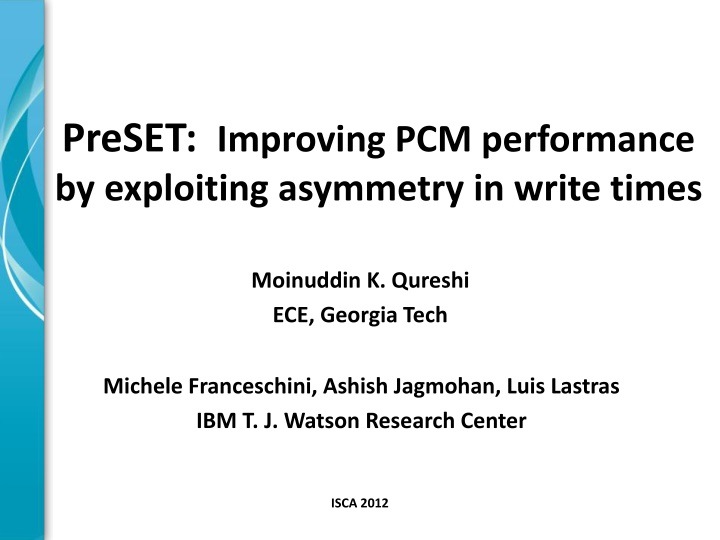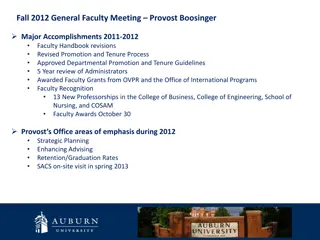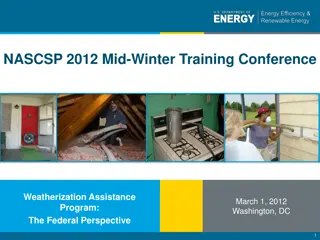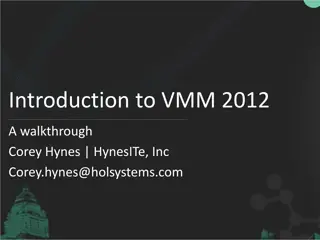
Leveraging Write Asymmetry for Enhanced PCM Performance
Explore how exploiting asymmetry in write times can improve performance in Phase-Change Memory (PCM). Understand the challenges, solutions, and experimental results in tackling slow write problems, with a focus on enhancing overall system efficiency.
Download Presentation

Please find below an Image/Link to download the presentation.
The content on the website is provided AS IS for your information and personal use only. It may not be sold, licensed, or shared on other websites without obtaining consent from the author. If you encounter any issues during the download, it is possible that the publisher has removed the file from their server.
You are allowed to download the files provided on this website for personal or commercial use, subject to the condition that they are used lawfully. All files are the property of their respective owners.
The content on the website is provided AS IS for your information and personal use only. It may not be sold, licensed, or shared on other websites without obtaining consent from the author.
E N D
Presentation Transcript
PreSET: Improving PCM performance by exploiting asymmetry in write times Moinuddin K. Qureshi ECE, Georgia Tech Michele Franceschini, Ashish Jagmohan, Luis Lastras IBM T. J. Watson Research Center ISCA 2012
In Memoriam John P. Karidis (1958-2012) IBM Distinguished Engineer Initiator & Tech Lead of PCM Project at IBM Exceptionally Versatile Researcher Butterfly Laptop Design (now in MOMA/NYC) Worlds fastest robotic probing arm PCM: material, devices, architecture, OS Great Human Being, Mentor, Colleague
Outline The Slow-Write Problem PreSET: Exploiting Write Asymmetry Experimental Results Discussion and Summary
Challenges for PCM Memories DRAM scaling is challenging PCM promises better scaling Key Challenges with PCM: 1. Limited Endurance (10-100M writes/cell) - Wear Leveling, Error correction, Graceful degradation 2. High Read Latency (2X-4X of DRAM) -Hybrid Memory, combining PCM and DRAM $ PCM DRAM Cache 3. High Write Latency (4X-8X higher than PCM read) Hybrid Memory Write performance remains one of the key bottleneck for PCM
Problem: Contention from Slow Writes Typical response: Writes not latency critical, use buffers/scheduling Once write gets scheduled, later arriving read request to bank waits RD1 Wait WR RD0 RD0 WR RD1 Our previous solution: Adaptive Write Cancellation [HPCA 10] RD1 WR RD0 RD0 WR RD1 WR (redone) Contention from slow writes increase read latency, lowers performance
Slow Write Problem: Quantified Baseline: 256MB DRAM$ + 32 PCM banks each with 32-entry WRQ PCM read latency 500 cycles, write latency 4000 cycles 1000 1.40 Effective Read Latency 900 1.30 Speedup 800 1.20 982 694 700 1.10 567 600 1.00 500 0.90 1 2 3 1 2 3 Baseline AWC No Writes Baseline AWC No Writes Our Goal: Get performance close to No Writes , without large WRQ
Outline The Slow-Write Problem PreSET: Exploiting Write Asymmetry Experimental Results Discussion and Summary
Not All Writes are Created Equal For typical PCM, write transitions have widely different latencies SET: Long Latency (~8x of read) RESET: Low Latency (similar to read) RESET Power SET time Writes are slow only in one direction
Insight: Exploit Write Asymmetry Typical memory operation writes many bits (512) Both transitions If memory writes constrained to only RESET, writes as fast as read Our Proposal: PreSET (Do SET operations off-the-critical path) 0xDEADBEEF 0xDEADBEEF PreSET 0xFADEDACE 0xFADEDACE 0x00000000 With PreSET, the write only does RESET operations Low Latency PreSET: Slow operation off-the-critical-path
When to do PreSET? As soon as the line is read Data corruption (if no write) When the write reaches memory system Too late Solution: When line gets first write in DRAM$, initiate PreSET Eviction to memory writes DRAM$ Install PreSET Window Initiating PreSET at 1st write to line in DRAM$ large PreSET window
Architecture Support for PreSET PI= PreSET Initiated PD= PreSET Done V D PI PD TAG DATA DRAM $ WRQ WR To Processor PCM Memory RD RDQ PreSET (Address only) PSQ PCM memory arrays needs to support bimodal writes: short and long Scheduling: PreSET are low priority, non-blocking for read requests PreSET requires small changes, PSQ is much simpler than WRQ
Working of PreSET PI=1 PD=1 V D PI PD TAG DRAM $ WRQ WR To Processor PCM RD RDQ PreSET (Address only) PSQ
Outline The Slow-Write Problem PreSET: Exploiting Write Asymmetry Experimental Results Discussion and Summary
Read Latency and Speedup Baseline AWC PreSET PreSET+AWC No Writes 35% 1000 1.4 Effective Read Latency 900 1.3 Speedup 800 1.2 700 1.1 600 1.0 500 0.9 1 2 3 4 5 1 2 3 4 5 PreSET is more effective than AWC PreSET+AWC obtains performance very close to No Writes
Impact on Write Queue Size No Writes 1.40 1.35 PreSET+AWC 1.30 1.25 Speedup 1.20 AWC 1.15 1.10 1.05 Baseline 1.00 0.95 1K Entries Total 0.90 8 64 128 256 16 32 1 2 3 4 5 6 8 (256KB) (512KB) (1MB) (32KB) (64KB) (128KB) Number of Entries in WRQ (per bank, 32 banks) AWC is reliant on having large WRQ, but (PreSET+AWC) is not
Where do the cycles go? Static/Dynamic throttling schemes for reduce overheads (in paper) PreSET increases memory utilization Power/Lifetime overheads
Power and Energy-Delay-Product AWC PreSET PreSET+AWC 1.00 1.40 1.35 0.95 Normalized Power 1.30 Normalized EDP 0.90 1.25 0.85 -24% 1.20 0.80 1.15 1.10 0.75 1.05 0.70 1.00 0.65 0.95 0.60 0.90 1 2 3 1 2 3 PreSET based schemes increase power but improve EDP significantly
Lifetime Impact Our workloads Lifetime Depends on Write Traffic Utilization (PreSET uses idle cycles)
Lifetime Impact PreSET+AWC AWC Baseline PreSET 20 System Lifetime (in Years) 16 12 8 4 0 Worst-Workload Lifetime Rated Average Lifetime 1 2 3 4 5 6 7 8 9 10 11 PreSET based schemes have lifetime of 5+ years, higher than rated
Outline The Slow-Write Problem PreSET: Exploiting Write Asymmetry Experimental Results Discussion and Summary
Isnt PreSET Similar to Flash ERASE? Yes: Both exploit asymmetry in write operations No: 1. PreSET is optional, ERASE mandatory 2. PreSET at same granularity as write, ERASE at 64x-128x 3. PreSET is in-place , ERASE out-of-place Out-of-place writes indirection tables (area, latency) For PCM, table needs to be per-line (~10MB for 32GB) Limited out-of-place PreSET for latency-critical writes: (database-commit, persistent memory, power failure) PreSET is optional and obviates the (bulky) indirection tables of ERASE
Summary PCM Slow-Write problem: Write blocks read, causes slowdown We exploit asymmetry in PCM writes: SET is slow, RESET is fast We propose PreSET, which performs SET ahead of actual write Starting PreSET on first-write on DRAM$ write is effective PreSET improves performance by 35% (No-Writes: 39%) Unlike AWC, PreSET does not rely on large WRQ (In paper: PreSET throttling for reduced overheads)











